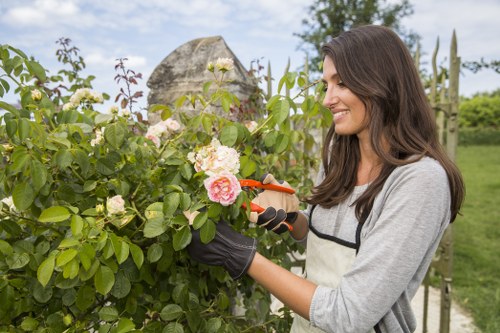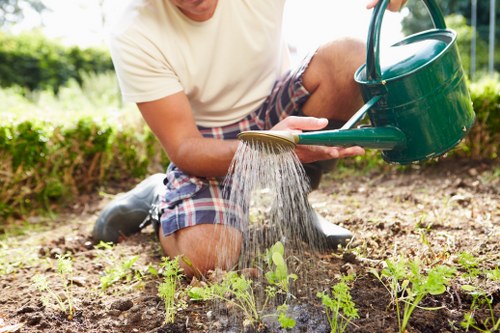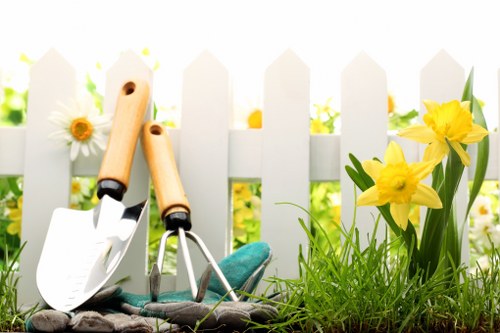Garden Maintenance in Grass Cutting

The Importance of Regular Grass Cutting
Maintaining a well-kept garden is essential for both aesthetic appeal and the health of your plants. One of the fundamental aspects of garden maintenance is grass cutting. Regular mowing not only keeps your lawn looking neat but also promotes stronger and healthier grass growth.
Consistent grass cutting helps prevent weeds from taking over, encourages thicker turf, and improves the overall resilience of your lawn against diseases and pests. By dedicating time to proper grass maintenance, you ensure that your garden remains a vibrant and inviting space throughout the year.
Understanding the right techniques and tools for grass cutting can make a significant difference in the quality of your lawn. Whether you prefer a manual mower or an automated system, the key is to tailor your approach to the specific needs of your garden.

Choosing the Right Grass Cutting Tools
Manual Mowers vs. Electric Mowers
Selecting the appropriate grass cutting tool is crucial for effective garden maintenance. Manual mowers, such as reel mowers, are eco-friendly options that provide a close cut without the noise and emissions associated with motorized models. They are ideal for small to medium-sized gardens and offer precise control over the mowing height.
On the other hand, electric mowers offer more power and are better suited for larger lawns. They come in both corded and cordless varieties, providing flexibility depending on your garden's layout. Electric mowers are generally easier to use for extended mowing sessions and require less physical effort compared to manual models.
When choosing between manual and electric mowers, consider factors such as the size of your garden, the type of grass, and your personal preferences in terms of maintenance and environmental impact.
Gas-Powered Mowers for Large Gardens
For expansive gardens with thick and high-growth grass, gas-powered mowers are often the most effective choice. These mowers provide the necessary power to cut through dense grass and are designed to handle larger areas efficiently. Although they are noisier and emit fumes, their performance and durability make them a popular option for serious gardeners.
Additionally, gas-powered mowers typically come with adjustable blades and various cutting height settings, allowing for greater customization based on your lawn's specific needs. Regular maintenance of these mowers, including engine care and blade sharpening, is essential to ensure longevity and optimal performance.
Investing in a high-quality gas-powered mower can significantly reduce the time and effort required for grass cutting, making it easier to maintain a pristine garden.

Best Practices for Effective Grass Cutting
Establishing a Mowing Schedule
Creating a consistent mowing schedule is vital for maintaining a healthy lawn. The frequency of grass cutting depends on factors such as grass type, season, and growth rate. Generally, lawns should be mowed once a week during the active growing seasons of spring and summer.
In cooler months or during periods of slower growth, reducing the mowing frequency can prevent unnecessary stress on the grass. Adjusting your mowing schedule according to these conditions helps maintain the right lawn height and promotes optimal growth patterns.
By adhering to a regular mowing routine, you can ensure that your grass remains evenly cut and that your garden continues to look its best.
Optimal Mowing Height
Maintaining the correct mowing height is essential for a healthy and attractive lawn. Cutting your grass too short can weaken the plants, making them more susceptible to weeds, pests, and diseases. Conversely, allowing the grass to grow too long can result in a tangled and unkempt appearance.
A general guideline is to keep your grass at a height of about 2.5 to 3.5 inches. This range provides enough coverage to shade the soil, reduce weed growth, and promote deeper root systems. However, specific mowing heights may vary depending on the grass species in your garden.
Regularly adjusting and maintaining the appropriate mowing height ensures that your lawn remains robust and visually appealing throughout the year.

Seasonal Considerations for Grass Cutting
Spring Maintenance
Spring is a critical time for lawn care, as it marks the beginning of the growing season. Before the first mow, it's important to remove any debris, such as leaves and twigs, to prepare the lawn for healthy growth. Dethatching and aerating the soil can also enhance nutrient absorption and promote vigorous grass development.
During spring, gradually increase the mowing frequency as the grass begins to grow more rapidly. Start by mowing at a higher height and gradually reduce it to the optimal level to avoid shocking the plants.
Implementing these practices in spring sets a strong foundation for a lush and thriving lawn throughout the year.
Summer Care
In the summer months, grass growth can become uneven due to fluctuating temperatures and moisture levels. It's important to monitor the lawn regularly and adjust mowing practices accordingly. Watering appropriately and avoiding mowing during peak heat hours can help maintain grass health.
Consider raising the mowing height slightly during periods of intense heat to provide extra shade to the roots and reduce water evaporation. Maintaining adequate moisture levels and avoiding over-mowing are key to preventing stress on the grass during the summer.
By adapting your mowing routine to the challenges of summer, you can preserve the vitality and color of your lawn.

Advanced Techniques for Superior Lawn Care
Mulching vs. Bagging
Deciding between mulching and bagging your grass clippings can impact the health of your lawn. Mulching involves finely chopping the grass clippings and redistributing them back onto the lawn, where they decompose and return valuable nutrients to the soil. This process reduces the need for additional fertilizers and promotes a sustainable gardening practice.
Alternatively, bagging involves collecting the grass clippings and disposing of them separately. While this method keeps the lawn clean and free of debris, it requires more effort and may necessitate additional fertilization to maintain soil fertility.
Choosing the appropriate method depends on your lawn's specific needs and your gardening preferences. Combining both techniques at different times of the year can optimize lawn health and appearance.
Edging and Trimming
Enhancing the boundaries of your lawn through edging and trimming adds a polished and professional look to your garden. Edging defines the perimeter of grass areas, creating clean lines along walkways, flower beds, and driveways.
Using specialized tools such as edgers or trimmers helps achieve precise cuts and maintain separation between different garden elements. Regular edging prevents grass from encroaching into unwanted areas and contributes to the overall neatness of your lawn.
Incorporating edging and trimming into your grass cutting routine elevates the aesthetic appeal and ensures that your garden maintains a well-structured and organized appearance.

Preventative Measures for Lawn Health
Weed Control
Effective weed control is integral to maintaining a healthy lawn. Weeds compete with grass for essential nutrients, water, and sunlight, potentially leading to weakened and unsightly grass. Regular mowing helps prevent weeds from establishing a foothold, as a well-maintained lawn naturally inhibits weed growth.
In addition to mowing, implementing pre-emergent and post-emergent herbicides can further reduce weed prevalence. Organic options, such as vinegar-based solutions or manual weeding, offer environmentally friendly alternatives for managing unwanted plants.
Maintaining proper grass height and soil health minimizes weed invasions, ensuring a lush and vibrant lawn.
Pest and Disease Management
Grass pests and diseases can significantly impact the health and appearance of your lawn. Common issues include fungal infections, grubs, and various insects that can damage grass blades and roots. Regular inspection of your lawn allows for early detection and intervention, preventing minor problems from escalating into major concerns.
Implementing integrated pest management (IPM) strategies, which combine biological, cultural, and chemical controls, promotes sustainable and effective disease and pest management. Maintaining proper mowing practices, such as avoiding mowing when grass is wet and ensuring adequate spacing, reduces the risk of disease spread.
Proactive pest and disease management ensures that your lawn remains resilient and healthy throughout the growing seasons.

Sustainable Practices in Grass Cutting
Eco-Friendly Mowing Techniques
Adopting eco-friendly mowing techniques contributes to sustainable garden maintenance and reduces your environmental footprint. Using electric or manual mowers lowers greenhouse gas emissions compared to gas-powered models, promoting cleaner air and a quieter garden environment.
Implementing mulching practices further enhances sustainability by recycling grass clippings, enriching the soil, and reducing the need for chemical fertilizers. Additionally, maintaining sharp mower blades ensures efficient cutting, which minimizes grass stress and the need for frequent mowing.
By prioritizing eco-friendly mowing methods, you support the health of your garden and the broader ecosystem.
Water Conservation
Effective water management is essential for sustainable lawn care. Overwatering can lead to water waste and create favorable conditions for pests and diseases, while underwatering stresses the grass and hinders growth.
Implementing irrigation systems that provide targeted and efficient water distribution ensures that your lawn receives adequate moisture without excess. Techniques such as drip irrigation or smart sprinklers can optimize water usage, conserving this valuable resource.
Combining proper mowing practices with water conservation strategies promotes a healthy and environmentally responsible lawn.

Hiring Professional Garden Maintenance Services
Benefits of Professional Grass Cutting
While DIY grass cutting can be fulfilling, hiring professional garden maintenance services offers numerous advantages. Professionals bring expertise and experience, ensuring that your lawn receives the best care tailored to its specific needs.
By entrusting grass cutting to experts, you save time and effort, allowing you to focus on other aspects of garden management or personal activities. Professionals also use high-quality equipment and stay updated on the latest lawn care techniques, enhancing the overall health and appearance of your lawn.
Investing in professional services can lead to a more consistently maintained and aesthetically pleasing garden, adding value to your property and providing a serene outdoor space.
Choosing the Right Service Provider
Selecting a reputable garden maintenance service is crucial for achieving desired results. When evaluating potential providers, consider factors such as experience, customer reviews, and the range of services offered. A reliable service should offer customized lawn care plans, utilizing appropriate mowing techniques and addressing specific garden challenges.
Additionally, environmentally conscious practices, such as the use of eco-friendly equipment and sustainable methods, are important considerations for many homeowners. Ensuring that the service provider aligns with your gardening values contributes to a harmonious and effective maintenance partnership.
Researching and selecting the right professional ensures that your lawn receives the highest standard of care and attention.

Conclusion: Achieving a Beautiful and Healthy Lawn
Effective grass cutting is a cornerstone of comprehensive garden maintenance. By understanding the importance of regular mowing, choosing the right tools, and implementing best practices, you can cultivate a lush and resilient lawn that enhances the beauty of your outdoor space.
Incorporating seasonal considerations, advanced techniques, and sustainable practices further elevates the quality of your garden, ensuring long-term health and vibrancy. Whether you opt for DIY grass cutting or enlist the help of professional services, prioritizing lawn care contributes to a serene and inviting garden environment.
Ready to transform your garden with expert grass cutting services? Contact us today and take the first step towards a stunning and well-maintained lawn.

